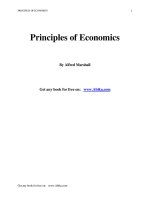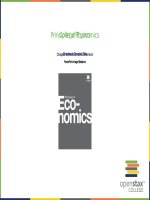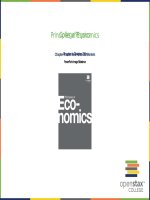Principles of economics openstax chapter34
Bạn đang xem bản rút gọn của tài liệu. Xem và tải ngay bản đầy đủ của tài liệu tại đây (2.07 MB, 152 trang )
College
Principles
ofPhysics
Economics
# Chapter
Chapter 34Chapter
Globalization
andTitle
Protectionism
PowerPoint
Image
Slideshow
Nyakundi
M. Michieka
What’s the Downside of Protection?
•
•
•
•
Governments are motivated to limit and alter market outcomes for political or
social ends
While governments can limit the rise in prices of some products, they cannot
control how much people want to buy or how much firms are willing to sell.
The laws of demand and supply still hold.
Trade policy is an example where regulations can redirect economic forces, but it
cannot stop them from manifesting themselves elsewhere.
2
What’s the Downside of Protection?
•
•
•
•
Flat-panel displays, the displays for laptop computers, tablets, and flat screen
televisions, are an example of such an enduring principle.
In the early 1990s, majority of flat-panel displays used in U.S. manufactured
laptops were imported, primarily from Japan.
The small but politically powerful U.S. flat-panel- display industry filed a
dumping complaint with the Commerce Department.
They argued that Japanese firms were selling displays at “less than fair value,”
which made it difficult for U.S. firms to compete.
3
What’s the Downside of Protection?
•
•
•
This argument for trade protection is referred to as anti-dumping.
•
Was this a successful exercise of U.S. trade policy?
Other arguments for protection in this complaint included national security.
Then, the U.S. International Trade Commission imposed a 63% dumping margin
(or tax) on the import of flat-panel displays.
4
Introduction to Globalism and Protectionism
In this chapter, we will cover:
•
•
•
•
•
Protectionism: An Indirect Subsidy from Consumers to Producers
International Trade and Its Effects on Jobs, Wages, and Working Conditions
Arguments in Support of Restricting Imports
How Trade Policy Is Enacted: Globally, Regionally, and Nationally
The Tradeoffs of Trade Policy
5
Introduction to Globalism and Protectionism
•
•
•
•
•
The world has become more connected economically.
1970, imports & exports 11% of U.S. GDP
Today they make up 32% of U.S. GDP
The U.S. is less internationally connected than most countries.
97% of Botswana’s economic activity is connected to trade.
6
Introduction to Globalism and Protectionism
•
•
As the world has become more globally connected, firms & workers in highincome countries like the U.S., Japan, or EU, perceive a competitive threat from
firms in medium-income countries like Mexico, China, or South Africa, that have
lower costs of living & therefore pay lower wages.
Firms & workers in low-income countries fear that they will suffer if they must
compete against more productive workers & advanced technology in highincome countries.
7
Introduction to Globalism and Protectionism
•
•
Environmentalists worry that multinational firms may evade environmental
protection laws by moving production to countries with loose pollution
standards, trading a clean environment for jobs.
Politicians worry that their country may become overly dependent on key
imported products, like oil, which in a time of war could threaten national
security.
8
Introduction to Globalism and Protectionism
•
All of these fears influence governments to reach the same basic policy
conclusion: to protect national interests, whether businesses, jobs, or security,
imports of foreign products should be restricted
•
This chapter analyzes such arguments
9
20.1 Protectionism: An Indirect Subsidy from Consumers to
Producers
•
•
•
When a government legislates policies to reduce or block international trade it
is engaging in protectionism.
Protectionist policies often seek to shield domestic producers and workers from
foreign competition.
Protectionism takes 3 forms:
(1) tariffs
(2) import quotas
(3) nontariff barriers
10
20.1 Protectionism: An Indirect Subsidy from Consumers to
Producers
1.
Tariffs are taxes imposed on imported goods & services, making imports more
expensive for consumers, discouraging imports.
•. For example, in recent years large, flat-screen televisions imported from China
have faced a 5% tariff rate.
11
20.1 Protectionism: An Indirect Subsidy from Consumers to
Producers
2.
Import quotas are numerical limitations on the quantity of products that can
be imported.
•. During the early 1980s, the Reagan Administration imposed a quota on the
import of Japanese automobiles.
•. The textile industry and sugar industry is governed by quotas
12
20.1 Protectionism: An Indirect Subsidy from Consumers to
Producers
3.
Nontariff barriers are all the other ways that a nation can draw up rules,
regulations, inspections, and paperwork to make it more costly or difficult to import
products.
•. A rule requiring certain safety standards can limit imports just as effectively as
high tariffs or low import quotas, for instance.
13
20.1 Protectionism: An Indirect Subsidy from Consumers to
Producers
•
•
•
Despite the barriers, the share of apparel sold in the U.S. that is imported rose
from about 50% in 1999 to about 75% today.
The number of U.S. jobs in textiles and apparel fell from about 542,000 in 2007
to 541,000 in 2012, an 8% decline.
Even more U.S. textile industry jobs would have been lost without tariffs,
however, domestic jobs that are saved by import quotas come at a cost.
14
20.1 Protectionism: An Indirect Subsidy from Consumers to
Producers
•
Because textile & apparel protectionism adds to the costs of imports,
consumers end up paying billions of dollars more for clothing each year.
•
When the U.S eliminates trade barriers in one area, consumers spend the money
they save on that product elsewhere in the economy—so there is no overall loss
of jobs for the economy as a whole.
15
20.1 Protectionism: An Indirect Subsidy from Consumers to
Producers
•
•
Realizing the compromises between nations that come about due to trade
policy, many countries came together in 1947 to form the General Agreement
on Tariffs and Trade (GATT)
This agreement has since been superseded by the World Trade Organization
(WTO), whose membership includes about 150 nations and most of the
economies of the world.
16
20.1 Protectionism: An Indirect Subsidy from Consumers to
Producers
•
WTO – the primary international mechanism through which nations negotiate
their trade rules—including rules about tariffs, quotas, and nontariff barriers.
17
Demand and Supply Analysis of Protectionism
•
•
Consider two countries, Brazil & the U.S. who produce sugar.
Each country has a domestic supply and demand for sugar, as detailed in Table
20.1 and illustrated in Figure 20.2.
18
Demand and Supply Analysis of Protectionism
•
•
•
In Brazil, without trade, the equilibrium price of sugar is 12 cents per pound and
the equilibrium output is 30 tons.
When there is no trade in the United States, the equilibrium price of sugar is 24
cents per pound and the equilibrium quantity is 80 tons.
These equilibrium points are labeled with the point E.
19
Figure 20.2 The Sugar Trade between Brazil and the United States
•
•
•
•
•
Before trade, the equilibrium price of sugar in Brazil is 12 cents a pound and for 24 cents per pound in the United States.
When trade is allowed, businesses will buy cheap sugar in Brazil and sell it in the United States.
This will result in higher prices in Brazil and lower prices in the United States.
Ignoring transaction costs, prices should converge to 16 cents per pound, with Brazil exporting 15 tons of sugar and the United States importing 15 tons of sugar.
If trade is only partly open between the countries, it will lead to an outcome between the free-trade and no-trade possibilities.
20
21
Demand and Supply Analysis of Protectionism
•
•
If trade between Brazil & U.S. becomes possible, firms buy sugar cheaply in
Brazil, & sell it at a higher price in the U.S.
As sugar is shipped from Brazil to the U.S., the quantity of sugar produced in
Brazil will be greater than Brazilian consumption (with the extra production
being exported), and the amount produced in the U.S. will be less than the
amount of U.S. consumption (with the extra consumption being imported).
22
Demand and Supply Analysis of Protectionism
•
•
•
Exports to the U.S. will reduce the supply of sugar in Brazil, raising its price.
•
•
The equilibrium with trade occurs at a price of 16 cents per pound.
Imports into the U.S. will increase the supply of sugar, lowering its price.
When the price of sugar is the same in both countries, there is no incentive to
trade further.
At that price, the sugar farmers of Brazil supply a quantity of 40 tons, while the
consumers of Brazil buy 25 tons.
23
Demand and Supply Analysis of Protectionism
•
•
•
The extra 15 tons of sugar production, shown by the horizontal gap between the
demand curve and the supply curve in Brazil, is exported to the U.S.
In the U.S., at a price of 16 cents, the farmers produce a quantity of 72 tons and
consumers demand a quantity of 87 tons.
The excess demand of 15 tons by American consumers, shown by the horizontal
gap between demand and domestic supply at the price of 16 cents, is supplied
by imported sugar.
24
Demand and Supply Analysis of Protectionism
•
Free trade typically results in income distribution effects, but the key is to
recognize the overall gains from trade, as shown in Figure 20.3.
25









